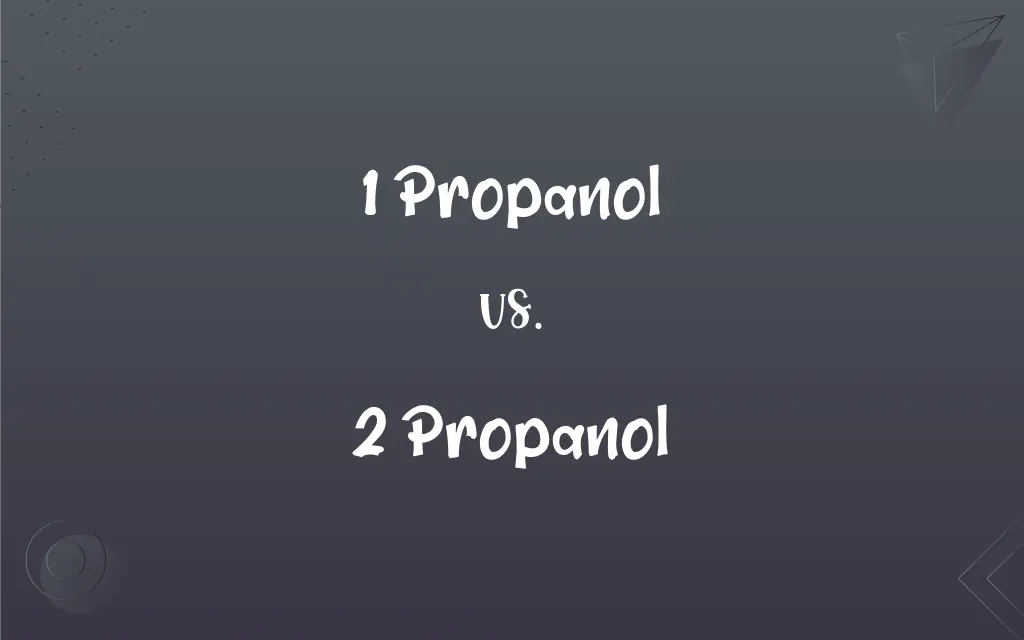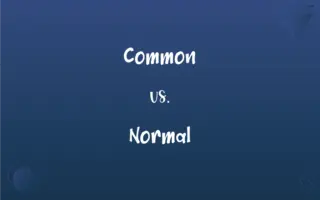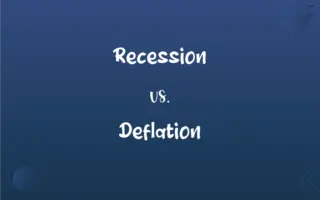1 Propanol vs. 2 Propanol: What's the Difference?
Edited by Aimie Carlson || By Janet White || Published on December 28, 2023
1-Propanol is a primary alcohol with the hydroxyl group at the end of the chain. 2-Propanol is a secondary alcohol with the hydroxyl group on the second carbon.

Key Differences
1-Propanol, also known as n-propanol, is a primary alcohol where the hydroxyl (-OH) group is attached to the first carbon of the chain. 2-Propanol, commonly known as isopropanol, is a secondary alcohol with the -OH group on the second carbon atom.
In 1-propanol, the -OH group's attachment to a terminal carbon makes it less reactive compared to 2-propanol, where the -OH group is connected to a central carbon, increasing its reactivity.
1-Propanol has a slightly higher boiling point due to its structure, which allows for stronger intermolecular forces than in 2-propanol. Conversely, 2-propanol has a lower boiling point and evaporates more quickly.
1-Propanol is often used as a solvent in industrial processes and in the manufacturing of cosmetics, while 2-propanol is widely used as a disinfectant and cleaning agent.
The difference in their molecular structure also results in different toxicity levels, with 2-propanol being more toxic than 1-propanol due to its secondary alcohol structure.
ADVERTISEMENT
Comparison Chart
Type of Alcohol
Primary alcohol
Secondary alcohol
Hydroxyl Group Position
At the end of the carbon chain
On the second carbon atom
Boiling Point
Slightly higher
Lower, evaporates quickly
Common Uses
Solvent, cosmetics manufacturing
Disinfectant, cleaning agent
Toxicity
Less toxic
More toxic
ADVERTISEMENT
1 Propanol and 2 Propanol Definitions
1 Propanol
An organic compound with the formula C3H7OH.
1-Propanol is produced in small amounts during fermentation.
2 Propanol
Widely used as a disinfectant and solvent.
2-Propanol is effective in removing oil and grease stains.
1 Propanol
A primary alcohol with three carbon atoms and a terminal hydroxyl group.
1-Propanol is used as a solvent in pharmaceuticals.
2 Propanol
Has the chemical formula C3H8O and is a colorless, flammable liquid.
2-Propanol evaporates quickly, making it useful for cleaning electronics.
1 Propanol
A colorless liquid with a slightly musty odor.
1-Propanol is less volatile compared to its isomer, 2-propanol.
2 Propanol
More toxic than its isomer 1-propanol due to its structure.
2-Propanol requires careful handling due to its higher toxicity.
1 Propanol
Has a moderate toxicity level and is used as an industrial solvent.
1-Propanol is preferred in industries for its less aggressive nature.
2 Propanol
A secondary alcohol, also known as isopropanol or isopropyl alcohol.
2-Propanol is commonly used for sterilizing medical equipment.
1 Propanol
Used as a precursor in the synthesis of other compounds.
1-Propanol undergoes oxidation to produce propionic acid.
2 Propanol
Commonly used in antiseptics, disinfectants, and detergents.
2-Propanol is a key ingredient in hand sanitizers.
1 Propanol
One of the two isometric forms of propanol; a primary alcohol with the formula CH3CH2CH2OH, formed naturally in small amounts during many fermentation processes and used as a solvent in the pharmaceutical industry mainly for resins and cellulose esters.
FAQs
What are the uses of 1-propanol?
As a solvent in industries and cosmetics manufacturing.
What is 1-propanol?
A primary alcohol with the formula C3H7OH.
Which is more reactive, 1-propanol or 2-propanol?
2-Propanol is more reactive due to its secondary alcohol structure.
How is 1-propanol produced industrially?
Often through hydration of propene.
How is 2-propanol commonly produced?
Usually by hydration of propene or reduction of acetone.
What is 2-propanol?
A secondary alcohol, also known as isopropyl alcohol.
What are the common uses of 2-propanol?
As a disinfectant, cleaning agent, and in hand sanitizers.
Which has a higher boiling point, 1-propanol or 2-propanol?
1-Propanol has a slightly higher boiling point.
How are 1-propanol and 2-propanol structurally different?
The -OH group in 1-propanol is at the end of the chain, while in 2-propanol, it's on the second carbon.
What are the physical properties of 2-propanol?
A colorless, flammable liquid with a strong odor.
Can 1-propanol be oxidized?
Yes, to form propionic acid.
Is 1-propanol safe for use in food industries?
It's not commonly used in food applications.
Are there any restrictions on using 2-propanol in cosmetics?
It's used, but with certain safety guidelines due to its toxicity.
What happens when 2-propanol is oxidized?
It forms acetone.
Is 2-propanol more toxic than 1-propanol?
Yes, 2-propanol is more toxic.
Can 1-propanol be used as a disinfectant like 2-propanol?
It's less effective as a disinfectant compared to 2-propanol.
Is 2-propanol more volatile than 1-propanol?
Yes, 2-propanol evaporates more quickly.
What are the physical properties of 1-propanol?
A colorless liquid with a musty odor.
Can both alcohols be found in household products?
2-Propanol is more common in household products like sanitizers.
How should 1-propanol and 2-propanol be stored?
In cool, well-ventilated areas away from ignition sources.
About Author
Written by
Janet WhiteJanet White has been an esteemed writer and blogger for Difference Wiki. Holding a Master's degree in Science and Medical Journalism from the prestigious Boston University, she has consistently demonstrated her expertise and passion for her field. When she's not immersed in her work, Janet relishes her time exercising, delving into a good book, and cherishing moments with friends and family.
Edited by
Aimie CarlsonAimie Carlson, holding a master's degree in English literature, is a fervent English language enthusiast. She lends her writing talents to Difference Wiki, a prominent website that specializes in comparisons, offering readers insightful analyses that both captivate and inform.






































































